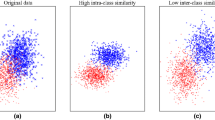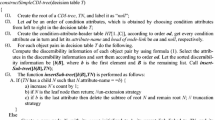Abstract
In real world, datasets have large number of attributes but few are important to describe them properly. The paper proposes a novel dimension reduction algorithm for real valued dataset using the concept of Rough Set Theory and clustering algorithm to generate the reduct. Here, projection of dataset based on two conditional attributes C i and C j is taken and K-means Clustering algorithm is applied on it with K = number of distinct values of decision attribute D of the dataset to obtain K clusters. Also the dataset is clustered into K-groups using Indiscernibility relation applied on the decision attribute D. Then the connecting factor k of combined conditional attributes (C i C j) with respect to D is calculated using two cluster sets and attribute connecting set ACS = {(C i C j \(\rightarrow^{\hspace*{-2.5mm}^k} D\)) for all C i,C j ∈ C, Conditional attribute set, and D (Decision attribute)} is formed. Each element (C i C j \(\rightarrow^{\hspace*{-2.5mm}^k} D\)) ∈ ACS implies that C i and C j connecting together partition the objects that yields (k*100) % similar partitions as made on D. Now an undirected weighted graph with weights as the connecting factor k is constructed using attribute connecting set ACS. Finally based on the weight associated with edges, the important attributes, called reduct are generated. Experimental result shows the efficiency of the proposed method.
Access this chapter
Tax calculation will be finalised at checkout
Purchases are for personal use only
Preview
Unable to display preview. Download preview PDF.
Similar content being viewed by others
References
Della Pietra, S., Della Pietra, V., Lafferty, J.: Inducing features of random fields. IEEE Transactions on Pattern Analysis and Machine Intelligence 19(4), 380–393 (1997)
Jensen, R., Shen, Q.: Fuzzy-Rough Attribute Reduction with Application to Web Categorization. Fuzzy Sets and Systems 141(3), 469–485 (2004)
Zhong, N., Skowron, A.: A Rough Set-Based Knowledge Discovery Process. Int. Journal of Applied Mathematics and Computer Science 11(3), 603–619 (2001); BIME Journal 05(1) (2005)
Alpaydin, E.: Introduction to Machine Learning. PHI (2010)
Pawlak, Z.: Rough set theory and its applications to data analysis. Cybernetics and Systems 29, 661–688 (1998)
K. Thangavel, A. Pethalakshmi. Dimensionality reduction based on rough set theory : A review, Journal of Applied Soft Computing, Volume 9, Issue 1, pages 1 -12, 2009.
Das, A.K., et al.: Reduct Generation by Formation of Directed Minimal Spanning Tree using Rough Set Theory. In: INDIA 2012(2012)
Hartigan, J.: Clustering Algorithms. Wiley, New York (1975)
Bang-Jensen, J., Gutin, G.: Digraphs: Theory, Algorithms and Applications. Springer, ISBN 1-85233-268-9
Murphy, P., Aha, W.: UCI repository of machine learning databases (1996), http://www.ics.uci.edu/mlearn/MLRepository.html
Hall, M.A.: Correlation-Based Feature Selection for Machine Learning, PhD thesis, Dept. of Computer Science, Univ. of Waikato, Hamilton, New Zealand (1998)
Liu, Setiono, R.: A Probabilistic Approach to Feature Selection: A Filter Solution. In: Proc. 13th Int’l Conf. Machine Learning, pp. 319–327 (1996)
Author information
Authors and Affiliations
Editor information
Editors and Affiliations
Rights and permissions
Copyright information
© 2012 Springer-Verlag Berlin Heidelberg
About this paper
Cite this paper
Sengupta, S., Das, A.K. (2012). Dimension Reduction Using Clustering Algorithm and Rough Set Theory. In: Panigrahi, B.K., Das, S., Suganthan, P.N., Nanda, P.K. (eds) Swarm, Evolutionary, and Memetic Computing. SEMCCO 2012. Lecture Notes in Computer Science, vol 7677. Springer, Berlin, Heidelberg. https://doi.org/10.1007/978-3-642-35380-2_82
Download citation
DOI: https://doi.org/10.1007/978-3-642-35380-2_82
Publisher Name: Springer, Berlin, Heidelberg
Print ISBN: 978-3-642-35379-6
Online ISBN: 978-3-642-35380-2
eBook Packages: Computer ScienceComputer Science (R0)




